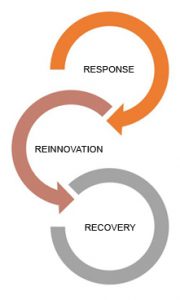Written by: Dr. Sharmila Banerjee
About the author: CEO at Green Chillies Motion Pictures | Founder and CEO -IWLF | The Leadership Consortium

INTRODUCTION
The COVID-19 pandemic began at a time of increasing global economic vulnerability. There were already genuine concerns of falling consumption levels and investment alongside rising unemployment. Brexit and the U.S-China trade war hadn’t helped and there was a palpable sense of uncertainty.
Most indicators now suggest that some of the largest economies stand on the precipice of the greatest real recession in nearly 100 years.
As far-fetched as it seems right now though, there will be a recovery and people are already asking: how different will the post-COVID-19 era be from the one we knew earlier? The most tangible effect we see is on technology adoption and general versatility with digital commerce and content. We anticipate a considerable acceleration on both fronts for individuals and businesses, which should hopefully do as much for financial inclusion and e-governance, as for streaming services.
However, not every industry subsector is impacted equally. Streaming media usage and video game engagement are booming. Consumers and remote workers view the broadband connectivity delivered by multichannel video programming distributors as more vital than ever before. There has been a perceptible increase in media consumption – TV, digital and gaming
especially – during the last few weeks as people have remained homebound. Monetization of this trend could prove challenging.
The segments most affected by the lockdown have been those that rely on a social gathering of people – films and
events – and the recovery here might take longer than anticipated. Certain sections of consumers – particularly those residing in COVID-19 hotspots for example – are likely to remain apprehensive of crowds
and display a preference for at-home media and entertainment options over outdoor experiences.
For the vast majority of companies, dealing with what is happening now is their first concern. However, the lessons learned from the global financial crisis show that this could be an opportunity to acquire high-quality assets that will accelerate growth when the market recovers.
Media and entertainment executives have long understood the necessity of reinventing their businesses to harness the potential of disruptive technologies and keep pace with changing consumer demands.
IMPACT ON VARIOUS SECTORS

https://legiteye.com/coronavirus-supreme-court-rejects-plea-to-quash-cases-against-lockdown-violators/
Impact on Box Office
With theatre releases postponed, shooting on hold, and cinema halls closed, absolutely nothing is certain. Even when theatres open, social distancing norms and weakened livelihoods are likely to prevent people from thronging to watch movies. With large-budgeted films competing for release dates, smaller productions may lose out. Production houses, keen on anticipated revenues, will have to put future projects on hold. A KPMG report points out that in order to stay afloat and avoid cash crunches, investments in large projects will most probably be avoided. In other words, the effect of the lockdown and virus are likely to carry on till FY21.
TV Shows
During the lock-down, TV consumption has actually increased, with so many people being home-bound. Viewers regularly watch news to stay up-to-date with the latest developments in the midst of the crisis. They also enjoy previously existing content. Doordarshan airing Mahabharat and Ramayan comes to mind. For two weeks, the channel became the most viewed in the world. The trouble of course is that advertising has shot down, as companies providing channels revenue are facing trouble themselves. The KPMG study predicts a 4-12 delay post ‘normalcy’ for monetization to be renewed. There is also danger that post lock-down, it could face increased competition from digital platforms.
Events
If the movie industry has it bad, then imagine an industry that is completely based on gatherings. Events include award shows, meetings, conferences, exhibitions, competitions, music festivals, etc. With huge events such as IPL suspended or canceled, the event management sector is looking at huge losses (INR 3,000 crore, at least as of the end of March). A survey conducted by the Events and Entertainment Management Association (EEMA) with 170 companies, found that more than 50 per cent of organizations had 90 per cent of their business canceled between March and July. More than 100 companies, of those surveyed, had faced a revenue reduction of INR 1 crore. The event industry provides livelihoods to 10 million people directly, and 50 million by way of allied sectors. The KPMG report sees business-to-business events picking up before business-to-consumer ones, expecting a 12-16 week delay post ‘normalcy’ for content supply and consumption of events to be renewed.

https://www.flickr.com/photos/joeross/32027278176
Impact OTT Platforms
In what are clearly dark times for M&E, OTT media services appear to be a glimmer of hope. There has been increased usage of these platforms over the last few months. Multiple platforms are providing subscription-free usage of their services to induce habit formation (KPMG), in the hope that this will lead to greater subscribers as we return to normalcy. Many users, who may have never experienced OTT services before, are opening themselves up and exploring them. They are also getting used to, and fond of, the ‘pause and play’ options that are not available on dish television operators.
Of course, as with television, platforms must make do with the content they already have. However, among other things, this trend has emphasized the permanence of digitization. Going forward, it is likely that advertisers turn their focus even more to the Internet. The Bollywood movie, Angrezi Medium, which could not have a box office release was released on Disney + Hotstar. This is not a viable option for all movies, however, considering that they may not reach the right audiences, or platforms may not be able to support big-budgeted films.
ECONOMIC IMPACT

Monetization in the M&E sector is predominantly reliant on advertising, which has seen a major contraction. Overall ad-spend is determined by the performance of sectors such as FMCG, e-commerce, automotive, financial services, real estate etc., all of which currently face their own challenges and could therefore take time to recover.
Insights into the Crises and its Aftermath
Ad-spend pressures to linger on the back of weak economy and lower domestic consumption
Longer time lag to return to normalcy for weaker economic sections of the populations
Outdoor entertainment (films, events, theme parks) particularly in COVID-19 hotspots to see lingering risk aversion even in the medium term. ‘Pent-up’ demand behavior among some sections of population may provide some respite
Delayed expansion plans though digital businesses aggressively target market opportunity, Which may not see the light of the day anytime soon.
RESPONSE, RENOVATION, AND RECOVERY
The economic recovery can be expected to present its fair share of complexities, as organisations respond to pressures on multiple fronts. With a hard reset for a number of businesses, all aspects of operations would need urgent attention. Organisations might need to be risk focused and innovate existing business models and processes to survive and emerge stronger.
Technology takes Centre Stage

- Digitization and building strong integrated digital models will become essential rather than optional in the post-COVID era
- For digital companies, increased focus is required on strengthening technology backbone, as digital penetration is expected to become more widespread once we regain normalcy
- Digital media consumption provides the opportunity to build faster and more nuanced profiles of users. The trend of using technology to enhance customer engagement – recommendation engines, personalization, feedback loops, data analytics – will only accelerate and deepen.
Building Supply Chain Resilience
-
Emphasis on deepening content pipeline, building content banks and reducing lead times
-
By leveraging technology and its associated tools telecommuting, cloud, AI/ ML – M&E companies should invest in improving content output efficiencies.
Cash Regains Supremacy
- Trend of risk aversion not just for consumers but also for organizations as liquidity allows for a great degree of comfort and confidence during stressful times
- Media spend by companies across sectors might be subject to a higher level of scrutiny and therefore M&E companies might need to offer more accurate return on investment calculations in traditional media and greater programmatic advertising options on digital platforms
Lowering Operating Leverage
- Emphasis on flexibility as companies look to move to a variable cost model and reduce fixed costs. As this crisis has shown, the ability to remain agile during downturns is a valuable asset
- Most content producers are paid ahead to allow them to manage their own working capital but such upfront contractual payments could be re-negotiated to avoid locking up cash
SWOT ANALYSIS OF MEDIA AND ENTERTAINMENT IN INDIA DURING THE COVID CRISIS

https://www.pikrepo.com/fdqid/person-using-macbook-pro-on-white-table/download/1024×768
Strengths
- M&E is still considered in India as an essential service and is permitted to continue (except theatres and events)
- Demand for Content is at an all-time high, due to need for escapism and knowledge consumption.
Weaknesses
- Inability to produce content like before
- High dependency on advertisers
- Inability to connect with and sell a large number of advertisers and SMEs (traditional media)
Opportunities
- Consolidation- Financially stronger brands consolidating weaker brands
- Content sharing between platforms.
- Huge scope for new content makers who have a bank of content
- Re-invention of sales through platforms to reach SMEs
- Manpower optimization
- Better monetization of library content
Threats
- Stressed balance sheet of small players. Increasing credit days due to liquidity crunch.
- Supply chain disruptions (print media)
- Continuous threat of the virus. One positive case can stall an entire production.
- Ad revenue from sectors like hospitality, travel and services will contract.
- Reduced liquidity of consumers
ACTION PLAN
While entering into commercial arrangements in future, in addition to re-evaluating the force majeure provisions, contracting parties will need to consider several other aspects afresh in light of the pandemic. I have summarized below some key aspects that we believe may be considered in the most common contractual arrangements in the entertainment industry
Production Arrangements
Production of new content may be one of the most challenging segments to manage once shootings are resumed, considering that production processes rely heavily on physical gatherings and interactions amongst people.
This may, therefore, require planning production schedules, timelines and budgets with a whole new perspective – including by possibly dividing the shoot schedules in a manner that shootings are undertaken with smaller group of people on a given day; choosing shooting spots and locations in areas that are least affected by the pandemic; making additional contingency provisions in the budgets for delay in supplies, re-shooting, illness of a crew member who may require time for recovery as well as quarantining among others.
Studios or platforms funding the production of any content, may consider including appropriate legal covenants in their contracts with production companies, in light of the above, and also specifically requiring them to adhere to all Government regulations and advisories regarding social distancing norms and mass gatherings as applicable to areas where shootings are undertaken.
Talent Engagements
https://bluemagpie.io/rawpixel-722814-unsplash-1/
Companies such as production houses, studios or platforms, directly engaging talent may consider inclusion of appropriate representations and covenants from the talents to ensure: adherence to all health advisories by the talent, disclosure of symptoms of any kind of contagion; necessarily adhering to self – quarantining measures, if and when required; restrictions from undertaking travel to regions most affected with COVID-19 during the term of engagement; obtaining adequate personal health insurances among others.
Further, such companies may also want to take appropriate waivers from the talents against any claims in respect of contracting of COVID-19 or any similar contagion in future, in the course of production and shootings.
There may also be other provisions to consider such as replacement of talent in case of contracting a contagion or prolonged illness, suspension or termination on this account and consequences thereafter. However, these may need to be negotiated on a case to case basis between the parties.
Content acquisitions and licensing
Parties to licensing and content acquisition contracts may examine their delivery requirements and obligations, since there may be delays on various accounts, such as delays in supplies; delay is completion of production due to non-availability or illness of crew members, non-availability of shoot locations, or a possible change in shoot locations in light of the pandemic, among others.
Further, the manner of delivery of content will also need to be assessed, since physical deliveries may be a challenge or may take longer in the near future, especially in case of cross border licensing and acquisitions. Drafting of the force majeure provisions in these contracts will also be of utmost significance and will need to be prudently negotiated between the parties.
CONCLUSION
While traditional media could face some challenges in the near to medium term, digital media businesses have fared relatively better, albeit only on the consumption side. There is likely to be a long-term – upward – shift in the integration of digital technologies into our everyday lives, and media and entertainment will be an immediate beneficiary. This is likely to be true across socio-economic groups – i.e. for both India and Bharat.
In addition to the lockdowns adversely impacting a large number of daily wage earners, and freelance creative talents, decreasing revenues and uncertainty around recovery from the pandemic, unfortunately also triggered a number of layoffs and pay-cuts in the media industry. In these circumstances the social and charitable measures taken by several media bodies, including broadcasters, IPRS, Producers Guild of India and other industry bodies, are certainly a much-needed lifeboat to sustain livelihoods of composers, artists, singers, authors, and daily wage earners in the entertainment industry.
Going forward, the industry will need to re-think various operational and legal aspects of the business, such as timelines, production costs and schedules, legal commitments etc., in order to adjust to the ‘new normal’ being presented to the world. OTT platforms, where a large chunk of the content library comprises acquired content, or is dependent on partnerships with third parties, may have to think of innovative ways of updating their existing content libraries, given that the production of new content may take much longer than anticipated earlier.

Given a rise in demand for content and increasing viewership, and the halts in production of new content, existing content is likely to become more valuable, and in time may increase competition not only for existing film and television libraries, but also for all new content. To meet the demand for content, the industry may also see increased partnerships between domestic and international media companies, leading to a rise in acquisition of foreign language content, and distribution of localized versions of such foreign content to suit different segments of the domestic audience.
During the Pandemic, the industry has gone through a harrowing experience. Respite, if any, was found online. Recovery will be slow, but those in the industry should not be discouraged. After all, it was often art and media that provided relief and support to the entire world.
Research Courtesy –KPGM Report

Dear Madam,
Very appropriate analysis !!
One of the most affected media is theater as live drama programs are almost stopped. They can be considered in “Threat” with the allied business partners